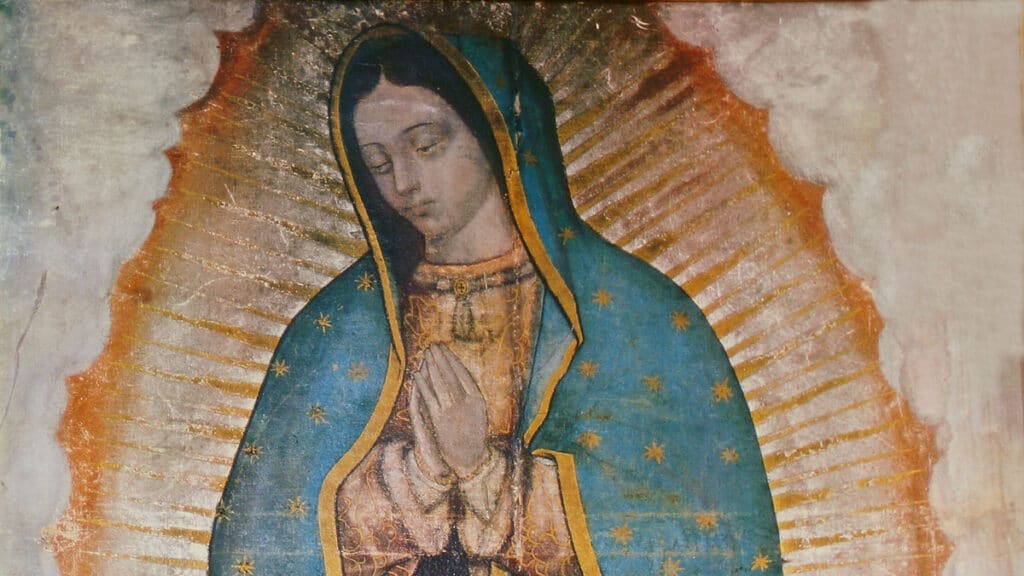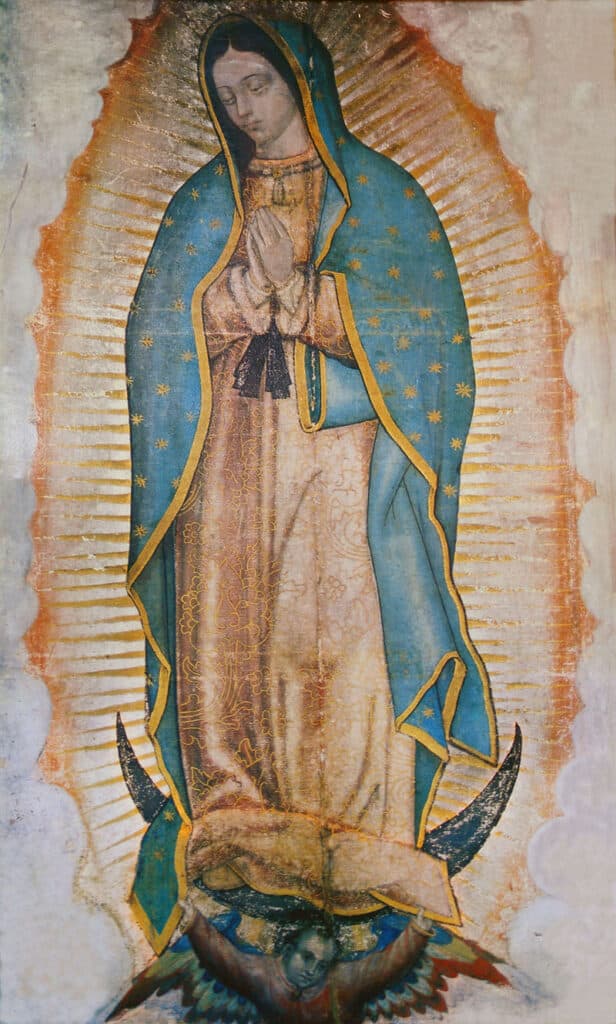
The Feast of the Virgin of Guadalupe is celebrated on December 12, especially in Mexico City. But Mexicans and the Diaspora cherish Guadalupe because she represents the mix of Indigenous Aztec and European Spanish traditions that defines México (and the Americas).
Many families celebrate Las Mañanitas a la Virgen de Guadalupe, a traditional Mexican birthday celebraton in her honor on the eve of December 12.
In New York City
Places to celebrate in New York City include the Shrine of Our Lady of Guadalupe in Greenwich Village, Manhattan; St Patrick’s Cathedral in Midtown East; or wherever you are, for the Earth is our temple.
Virgin of Guadalupe
The Virgin of Guadalupe (La Virgen de Guadalupe) is a Marion miracle from December 12, 1531 that blends Aztec and Christian traditions into the icon of Mexican cultural identity. Like the Mexican people, the Virgin of Guadalupe is mixed race and has a multicultural identity.
The cloak that bears her image is enshrined in the Basilica of Our Lady of Guadalupe on Tepeyac Hill in Mexico City.
Her Story

This story was created by the Mexican people. It was not created by the Catholic church. Though it is now part of the Catholic story, the priests did not accept it at first.
Juan Diego was a native Mexican peasant. That means he was Aztec, an Indigenous American. In a vision on the Hill of Tepeyac, a woman asked Juan Diego to build a church for her on the site. She spoke to him in the Aztec language Nahuatl.
Juan Diego told the archbishop of Mexico City about his vision, but the archbishop dismissed it. Mary appeared to Juan Diego again and asked him to keep trying.
Juan Diego spoke with the archbishop again and was instructed to go back to the spot and ask for a sign to prove that she was indeed the Virgin Mary. The Virgin appeared and told Juan Diego should would provide a sign on the next day.
The next day Juan Diego’s uncle was dying so Juan Diego took care of him instead of visiting the hill.
On his way to the hill on the day after (December 12), the Virgin appeared and scolded Juan Diego for not believing in her. She told him that his uncle was now well, and that he should go up the hill and gather flowers.
Nothing grows on that hill in December, but when Juan Diego went there, he found Castilian roses. These are not native to Mexico. They are Spanish roses. Juan Diego put the flowers in his cloak and went to see the archbishop.
When Juan Diego opened his cloak in front of the archbishop, the roses spilled out revealing the image of Our Lady of Guadalupe that is revered today.
The next day, Juan Diego found that his uncle was indeed well. The Virgin Mary had appeared to Diego’s uncle and asked to be known as Guadalupe.
Context
There is some controversy about whether the Church just made this all up to encourage Indigenous People to convert from their traditional beliefs. The Christian Colonizers believed that Jesus would return when all the world’s people were baptized. They forced conversions with the sword, the gun, and the match. Because Christianity was promoted by Roman warriors, violence is either very Christian or not Christian at all depending on your point of view. The message of Christ is certainly not violence, but rather treating others the way you want to be treated, loving your neighbor, and helping the poor.
It does not matter whether you consider the Virgin of Guadalupe to be religious fact or myth. What is important is her impact on the hearts and minds of the people.
If you are not Latin, Marian apparitions may seem silly. If you are Latin, Marian apparitions may be very real.
This apparition happened in 1531, just ten years after the Spanish “conquest” of the Aztecs. The Aztecs were one of the great civilizations of the Americas. At their height, they were more advanced than Europeans in many ways.
To put ourselves in context, imagine that a spaceship landed in Washington D.C. Then space creatures took over our country and forced us to convert to their religion. That would be a pretty big psychological shock. We would probably try to hold onto our traditions wherever possible. We would look for ways to make sense of what happened in order to survive. (Strange, but this seems to be happening in our country now.)
The Meaning of the Virgin of Guadalupe
You are entitled to your own interpretation of the meaning of the Virgin of Guadalupe.
Before the Spanish conquest, there was a temple to the Aztec mother goddess Tonantzin on the hill of Tepeyac. The Virgin of Guadalupe spoke the Aztec language Nahuatl. She is a dark-skinned woman of mixed race. She is revered because she is not entirely foreign. She is like many us.
Around the Virgin of Guadalupe’s feast a few years ago, we had a little conversation (I know that’s crazy, but hear me out). She said, “The holiday season isn’t about him. It’s not even about me. It’s about something bigger: Mother Earth.”
The Solstice marks the renewal of Mother Earth’s annual cycle of life. It is the prehistoric root of all the December and January celebrations. Christmas has taken over the season, and other religions don’t want any part of it, but the solstice is for all humanity. That’s who The Virgin loves ~ all humanity. And everyone has a right to celebrate the holidays in their own way.
We think the message of our the Virgin of Guadalupe is that it is okay for us to blend traditions, and that we should keep trying. When people come together with love, miracles are indeed possible.
